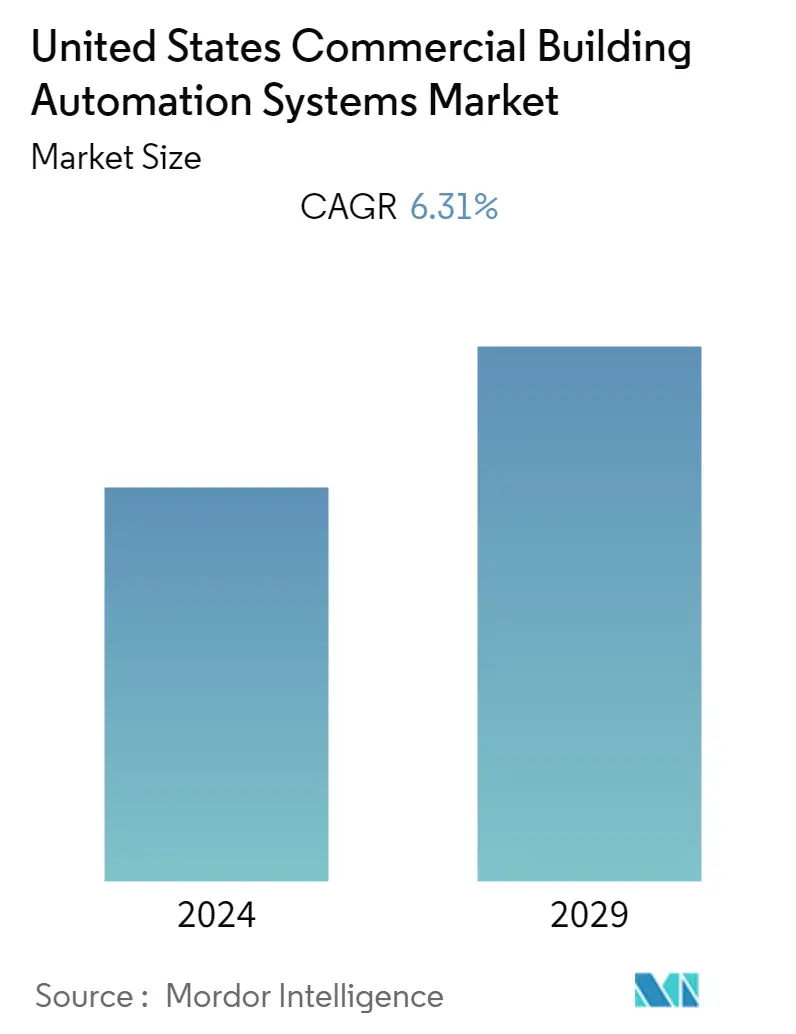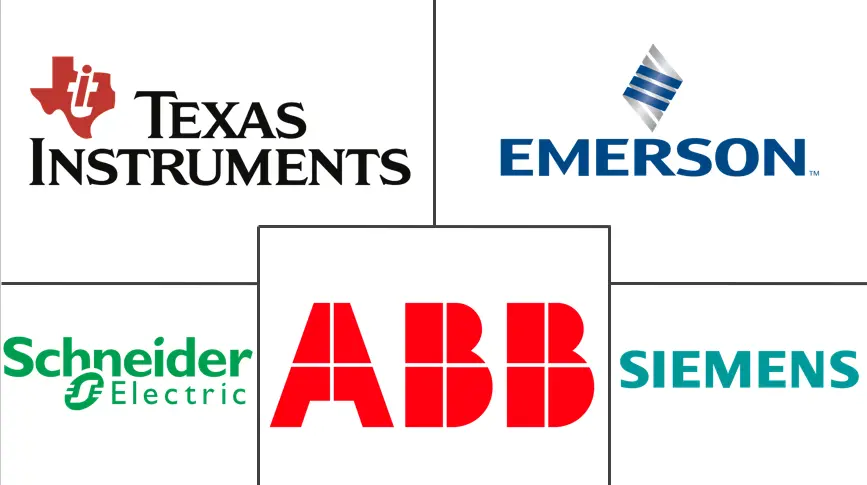Market Size of United States Commercial Building Automation Systems Industry

| Study Period | 2019 - 2029 |
| Base Year For Estimation | 2023 |
| Forecast Data Period | 2024 - 2029 |
| Historical Data Period | 2019 - 2022 |
| CAGR | 6.31 % |
| Market Concentration | Medium |
Major Players
*Disclaimer: Major Players sorted in no particular order |
US Commercial Building Automation Market Analysis
The US commercial building automation systems market was valued at USD 4.75 billion in 2020, and it is expected to reach USD 6.63 billion by 2026, registering a CAGR of 6.31% over the period of 2021-2026. Building automation systems connect and integrate different facility technologies, including HVAC, surveillance, lighting, and security, through information flow to a monitoring point. The requirement for energy management and the growing emphasis on overcoming utility costs continue to drive the adoption of building automation systems in the commercial sector. In the United States, most commercial buildings are equipped with these solutions.
- As buildings become more infused with IT and networking technology, building managers and security professionals are becoming aware of the risk of smart building security. Financial services institutions and other industries are potentially valuable targets from the hacker's perspective, and they should prioritize smart building security. Hence, such trends would drive the demand for intelligent security systems solutions.
- According to the New York State Energy Research and Development Authority, enabling real-time energy management systems and smart technologies could reduce costs by an average of 15% and increase the bottom line by creating an environment that encourages employee productivity and reduces energy waste, according to the New York State Energy Research and Development Authority (NYSERDA).
- Further, the market factor which is challenging the growth is the increasing office vacancy. According to the National Association of Realtors, the office vacancy rates in the United States witnessed a significant increase in 2020. The decline of office spaces, thus, negatively affects building automation systems growth.
- Moreover, with the COVID-19 impact, multiple energy management software providers extend their services beyond energy management systems by building health assessment solutions. For instance, in May 2020, Honeywell launched an integrated set of solutions for helping commercial building owners improve the health of their building environments and energy efficiency. These solutions further help building owners operate more cleanly and safely and comply with the social distancing policies.
US Commercial Building Automation Industry Segmentation
Building automation systems (BASs) or building automation control systems exhibit functions, such as controlling the building's environment, operating systems depending on the energy demand, and monitoring the system performance. The systems produce sound alerts as required. A BAS has related hardware and software to control and monitor electrical systems, heating, ventilation, air-conditioning (HVAC), lighting control, security, and surveillance, among others in buildings (commercial, residential, and commercial).
| Product Type | |
| HVAC | |
| Security and Access Control Systems | |
| Energy Management Systems | |
| Lighting Management Systems |
| Application | |
| Institutional | |
| Office | |
| Retail |
United States Commercial Building Automation Systems Market Size Summary
The US commercial building automation systems market is experiencing a steady growth trajectory, driven by the increasing need for energy management and cost reduction in commercial spaces. These systems integrate various facility technologies such as HVAC, lighting, surveillance, and security, facilitating efficient monitoring and control. The emphasis on energy efficiency and the reduction of utility costs are significant factors propelling the adoption of these systems across the United States. As buildings become more integrated with IT and networking technologies, there is a growing awareness of the security risks associated with smart buildings, particularly in sectors like financial services. This has led to an increased demand for intelligent security solutions, further boosting the market's expansion.
Despite the positive growth outlook, the market faces challenges such as rising office vacancy rates, which can negatively impact the demand for building automation systems. The COVID-19 pandemic has also influenced market dynamics, with providers expanding their offerings to include building health assessment solutions. Innovations in energy management technologies, such as wireless sensor networks and green HVAC systems, are contributing to the market's development by enhancing energy efficiency and reducing costs. Major players in the market, including ABB, Siemens, Schneider Electric, Emerson Electric, and Texas Instruments, are focusing on expanding their global presence and introducing new products to capture a larger market share. Strategic alliances and investments in innovative technologies are also key strategies employed by these companies to strengthen their market position.
United States Commercial Building Automation Systems Market Size - Table of Contents
-
1. MARKET INSIGHTS
-
1.1 Market Overview
-
1.2 Industry Attractiveness - Porter's Five Forces Analysis
-
1.2.1 Bargaining Power of Suppliers
-
1.2.2 Bargaining Power of Buyers
-
1.2.3 Threat of New Entrants
-
1.2.4 Threat of Substitutes
-
1.2.5 Intensity of Competitive Rivalry
-
-
1.3 Assessment of the Impact of COVID-19 on the Market
-
-
2. MARKET SEGMENTATION
-
2.1 Product Type
-
2.1.1 HVAC
-
2.1.2 Security and Access Control Systems
-
2.1.3 Energy Management Systems
-
2.1.4 Lighting Management Systems
-
-
2.2 Application
-
2.2.1 Institutional
-
2.2.2 Office
-
2.2.3 Retail
-
-
United States Commercial Building Automation Systems Market Size FAQs
What is the current United States Commercial Building Automation Systems Market size?
The United States Commercial Building Automation Systems Market is projected to register a CAGR of 6.31% during the forecast period (2025-2030)
Who are the key players in United States Commercial Building Automation Systems Market?
Siemens, Emerson Electric Co, ABB, Schneider Electric and Texas Instruments Inc are the major companies operating in the United States Commercial Building Automation Systems Market.

